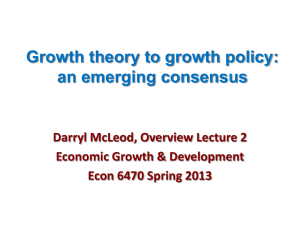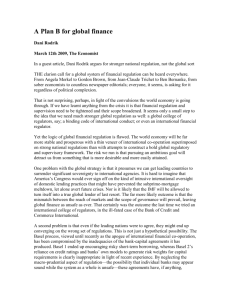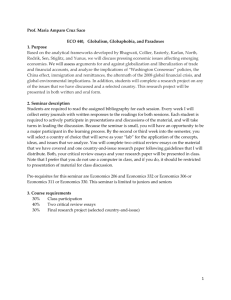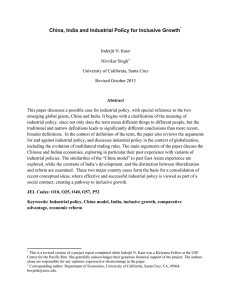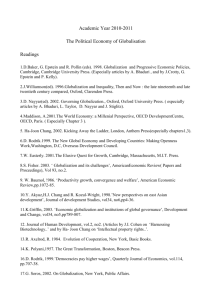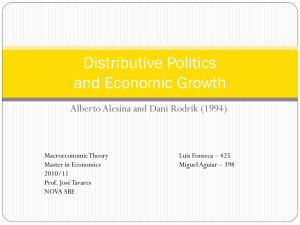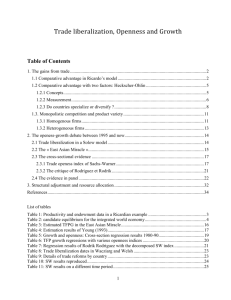King Kong Meets Godzilla: The World Bank and the East Asian Miracle
advertisement
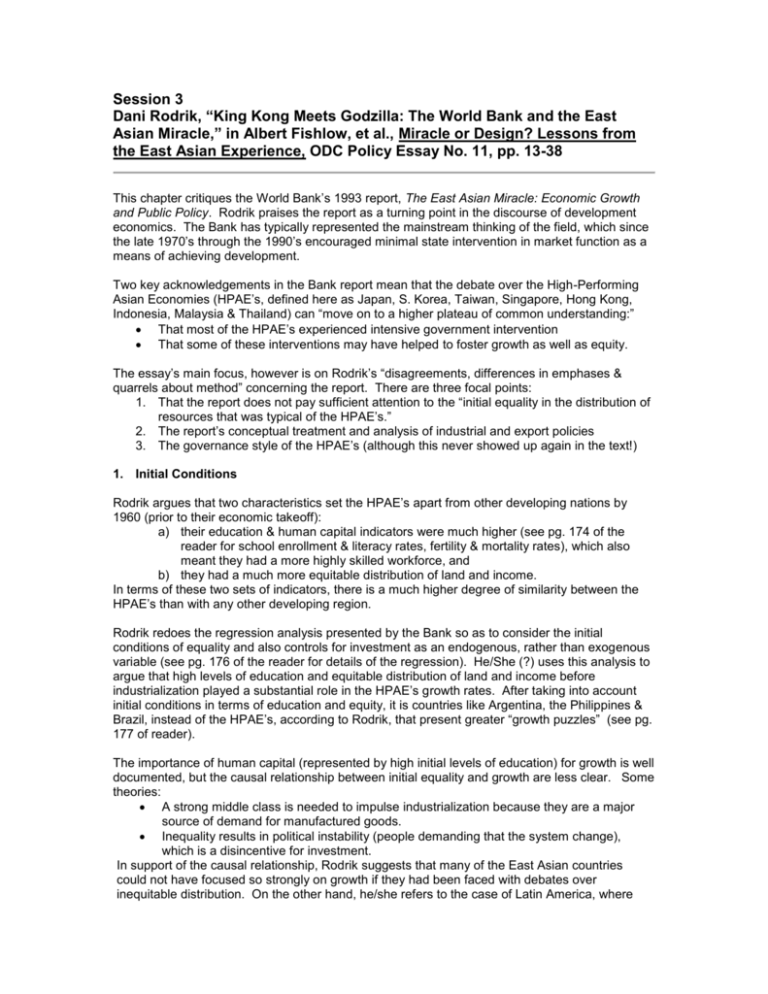
Session 3 Dani Rodrik, “King Kong Meets Godzilla: The World Bank and the East Asian Miracle,” in Albert Fishlow, et al., Miracle or Design? Lessons from the East Asian Experience, ODC Policy Essay No. 11, pp. 13-38 This chapter critiques the World Bank’s 1993 report, The East Asian Miracle: Economic Growth and Public Policy. Rodrik praises the report as a turning point in the discourse of development economics. The Bank has typically represented the mainstream thinking of the field, which since the late 1970’s through the 1990’s encouraged minimal state intervention in market function as a means of achieving development. Two key acknowledgements in the Bank report mean that the debate over the High-Performing Asian Economies (HPAE’s, defined here as Japan, S. Korea, Taiwan, Singapore, Hong Kong, Indonesia, Malaysia & Thailand) can “move on to a higher plateau of common understanding:” That most of the HPAE’s experienced intensive government intervention That some of these interventions may have helped to foster growth as well as equity. The essay’s main focus, however is on Rodrik’s “disagreements, differences in emphases & quarrels about method” concerning the report. There are three focal points: 1. That the report does not pay sufficient attention to the “initial equality in the distribution of resources that was typical of the HPAE’s.” 2. The report’s conceptual treatment and analysis of industrial and export policies 3. The governance style of the HPAE’s (although this never showed up again in the text!) 1. Initial Conditions Rodrik argues that two characteristics set the HPAE’s apart from other developing nations by 1960 (prior to their economic takeoff): a) their education & human capital indicators were much higher (see pg. 174 of the reader for school enrollment & literacy rates, fertility & mortality rates), which also meant they had a more highly skilled workforce, and b) they had a much more equitable distribution of land and income. In terms of these two sets of indicators, there is a much higher degree of similarity between the HPAE’s than with any other developing region. Rodrik redoes the regression analysis presented by the Bank so as to consider the initial conditions of equality and also controls for investment as an endogenous, rather than exogenous variable (see pg. 176 of the reader for details of the regression). He/She (?) uses this analysis to argue that high levels of education and equitable distribution of land and income before industrialization played a substantial role in the HPAE’s growth rates. After taking into account initial conditions in terms of education and equity, it is countries like Argentina, the Philippines & Brazil, instead of the HPAE’s, according to Rodrik, that present greater “growth puzzles” (see pg. 177 of reader). The importance of human capital (represented by high initial levels of education) for growth is well documented, but the causal relationship between initial equality and growth are less clear. Some theories: A strong middle class is needed to impulse industrialization because they are a major source of demand for manufactured goods. Inequality results in political instability (people demanding that the system change), which is a disincentive for investment. In support of the causal relationship, Rodrik suggests that many of the East Asian countries could not have focused so strongly on growth if they had been faced with debates over inequitable distribution. On the other hand, he/she refers to the case of Latin America, where unequal distribution of wealth is often cited as a cause of macroeconomic instability and populist policies. Rodrik concludes this section by saying policies common to the HPAE’s, and referred to by the Bank as part of a “market-friendly” approach, were not fueled by the market alone but rather “greatly facilitated by the relative equality of income and wealth.” He/she also posits that the HPAE’s levels of human capital formation are due to initial levels of education rather than changes after 1960 (as the Bank report claims). In short, Rodrik feels that the Bank’s failure to address initial conditions in the HPAE’s is a major flaw in the report’s conclusions. 2. Industrial and Export Policies Rodrik has several conceptual problems with the Bank’s conclusions regarding the success of interventionist policies. In summary, the author finds that the Bank’s “analysis of the consequences of industrial policy lacks credibility.” Rodrik specifically question the conclusion reached by the Bank regarding a) the inefficacy of industrial promotion policies and b) the unqualified success of “export push” (a.k.a. export subsidization) or open trade policies. A. Inefficacy of industrial promotion policies “Did industrial policy influence structural change?” This section is quite dense, but the author’s main point seems to be that the Bank tried to prove that industry promotion failed to cause structural change by comparing the parallel growth of industries that were actively promoted by governments with the growth of those that were not. According to the Bank, the fact that industries that were not promoted by the government continued to dominate the economic structure of the HPAE’s proves the failure of the government’s promotion. However, Rodrik says this conclusion is flawed because it is too broad: the Bank didn’t consider or compare specific policies and their consequences but simply the overall picture. The Bank also examined the correlation between growth in value added and wages for each industrial sector; assuming that if market influence had been predominant, the correlation would be negative and that if government influence predominated it would be positive. Rodrik finds this analysis inconclusive and “meaningless,” and comes away with the feeling that the Bank authors ran this particular regression to simply confirm their prior hunch (if you want detail on why, check pg. 181 of the reader – I had trouble following the argument). “Did industrial policy enhance productivity change?” On this point the Bank compared the increase in productivity in sectors that were actively promoted by the state with the increase in productivity in other sectors, concluding that sector promotion did little to increase productivity. However, Rodrik’s point is that instead of making cross-sector comparisons, the Bank should have tried to find out what would have happened to productivity in a single sector with and without promotional policies. The promotion could be considered successful, then, if it productivity increased relative to what would have happened if the industry had been left alone. Rodrik suggests two ways of doing this: comparing the same industry from two different countries (one promoted, the other not), or analyzing sectoral productivity across a series of “sub periods” in which promotional policies changed. B. Success of “export fetishism” The Bank concludes that export subsidization has been the one unqualified success out of the HPAE’s interventionist policies. Rodrik thinks this is glossed-over view because of weak arguments on three fronts: 1. “Technology spillover:” the report doesn’t offer any direct causal evidence that supports its claim that exports sustain growth by generating technological spillovers to other sectors. According to Rodrik the most convincing argument in this area, that increased contact with foreign customers enhances technology transfer, is simply not that convincing. 2. “Cross-country evidence that more-open economies grow faster:” Rodrik’s opinion is that the evidence presented does not prove that trade-oriented economies grow faster. Again, he/she faults the regression analysis performed by the Bank authors for including endogenous variables. Rodrik also says that the indicator used for the analysis, the Dollar index, is not a credible measurement of an economy’s openness. (If you are more comfortable with regression analysis than I am, you may get more out of this section – see pp 183-4 of the reader). 3. I think Rodrik also planned to get into the Bank’s conclusion regarding the use of exports as “performance standards” and the way this raises the efficacy of government interventions, but the article seems to end rather abruptly. Maybe a last page is missing?.
